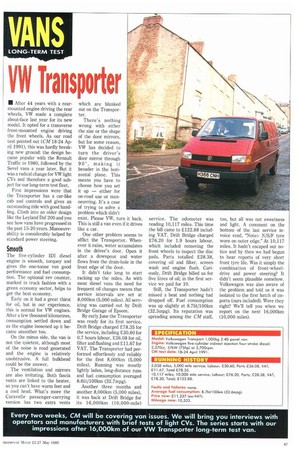VW Transporter
Page 49

If you've noticed an error in this article please click here to report it so we can fix it.
I After 44 years with a rearmounted engine driving the rear wheels, VW made a complete about-face last year for its new model. It opted for a transverse front-mounted engine driving the front wheels. As our road test pointed out (CM 18-24 April 1991), this was hardly breaking new ground: the design became popular with the Renault Traffic in 1980, followed by the Sevel vans a year later. But it was a radical change for VW light CVs and therefore a good subject for our long-term test fleet.
First impressions were that the Transporter has a car-like cab and controls and gives an outstanding ride with good handling. Climb into an older design like the Leyland Daf 200 and you see how vans have progressed in the past 15-20 years. Manoeuvrability is considerably helped by standard power steering.
Smooth
The five-cylinder IDI diesel engine is smooth, torquey and gives the one-tonne van good performance and fuel consumption. The optional rev counter, marked in truck fashion with a green economy sector, helps to get the best economy.
Early on it had a great thirst for oil, but in our experience, this is normal for VW engines. After a few thousand kilometres, consumption settled down and as the engine loosened up it became smoother too.
On the minus side, the van is not the quietest, although most of the noise is road generated and the engine is relatively unobtrusive. A full bulkhead could be the answer.
The ventilation and mirrors are also irritating. Both fascia vents are linked to the heater, so you can't have warm feet and a cool head. What's more the Caravelle passenger-carrying version has two extra vents which are blanked out on the Transporter.
There's nothing wrong with either the size or the shape of the door mirrors, but for some reason, VW has decided to turn the driver's door mirror through 90, making it broader in the horizontal plane. This means you have to choose how you set it up — either for on-road use or manoeuvring. It's a case of trying to solve a problem which didn't exist. Please VW, turn it back. This is still a van even if it drives like a car.
One other problem seems to afflict the Transporter. Whenever it rains, water accumulates in the driver's door. Open it after a downpour and water flows from the drain-hole in the front edge of the door.
It didn't take long to start racking up the miles. As with most diesel vans the need for frequent oil changes means that service intervals are set at 8,000km (5,000 miles). All servicing was carried out by Drift Bridge Garage of Epsom.
By early June the Transporter was ready for its first service. Drift Bridge charged £78.35 for the service, including £30.60 for 0.7 hours labour, £.36.08 for oil, filter and flushing and £11.67 for VAT. The Transporter had performed effortlessly and reliably for the first 8,000km (5,000 miles). Running was mostly lightly laden, long-distance runs and fuel consumption averaged 8.6lit/1001un (32.7mpg).
Another three months and another 8,000km (5,000 miles), it was back at Drift Bridge for its 16,000km (10,000-mile) service. The odometer was reading 10,117 miles. This time the bill came to £122.88 including VAT. Drift Bridge charged £76.20 for 1.9 hours labour, which included removing the front wheels to inspect the disc pads. Parts totalled £28.38, covering oil and filter, screen wash and engine flush. Curiously, Drift Bridge billed us for five litres of oil; in the first service we paid for 10.
Still, the Transporter hadn't missed a beat and nothing had dropped off. Fuel consumption was up slightly at 8.7lit/100km (32.5mpg). Its reputation was spreading among the CM staff,
too, but all was not sweetness and light. A comment on the bottom of the last service invoice read, "Note:IC/S/F tyre worn on outer edge." At 10,117 miles. It hadn't escaped our notice and by then we had begun to hear reports of very short front tyre life. Was it simply the combination of front-wheeldrive and power steering? it didn't seem plausible somehow. Volkswagen was also aware of the problem and told us it was isolated to the first batch of imports (ours included). Were they right? We'll tell you when we report on the next 16,000km (10,000 miles).




























































































